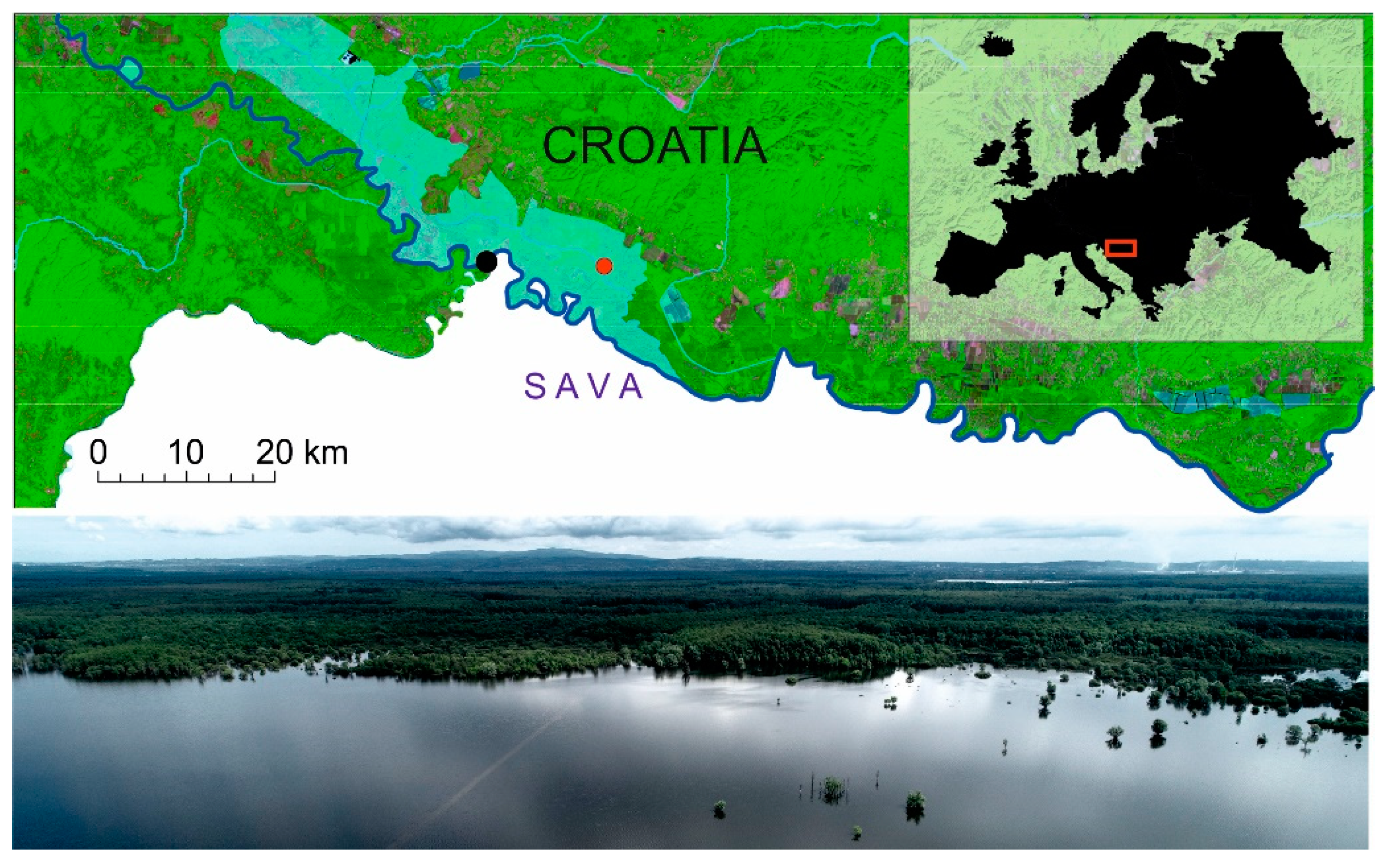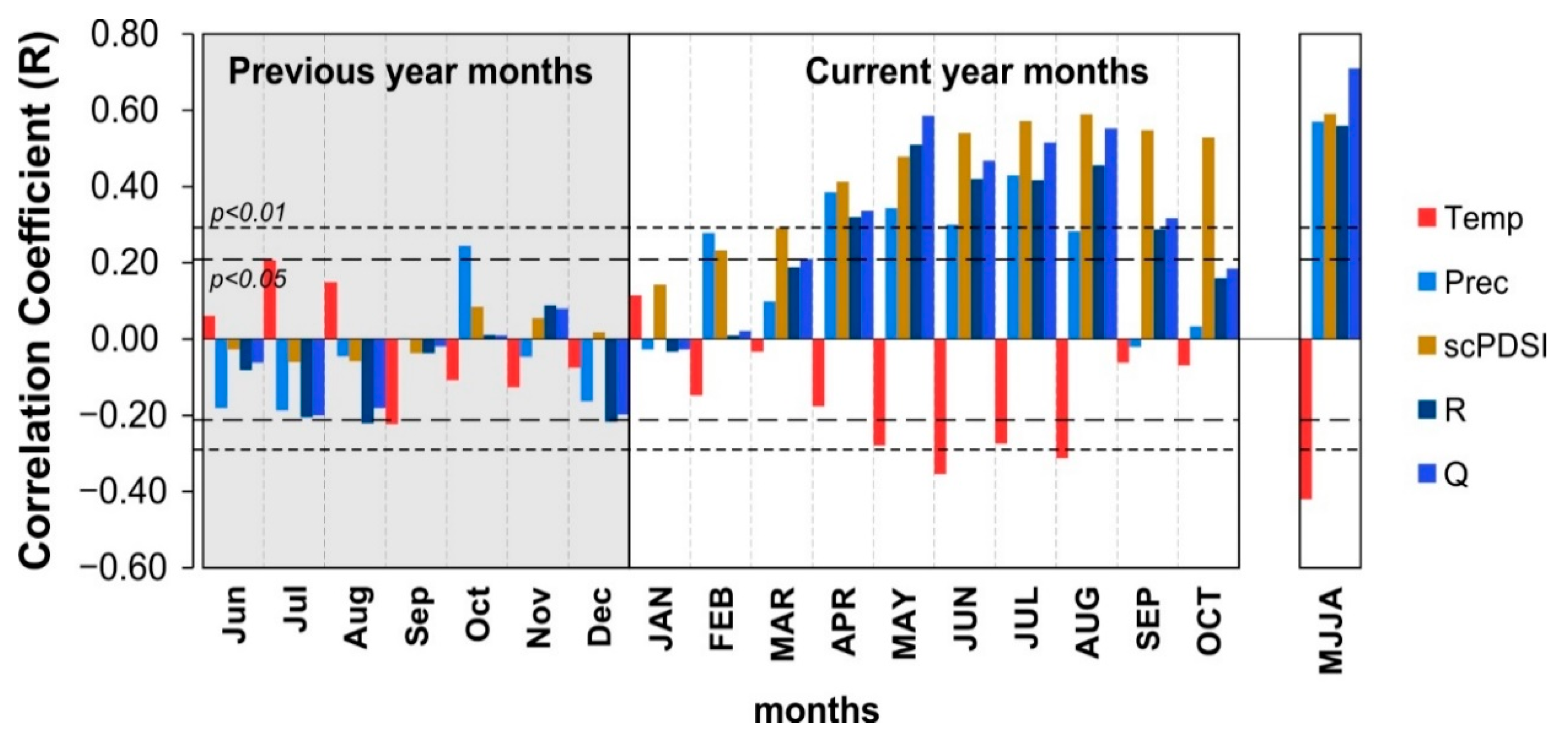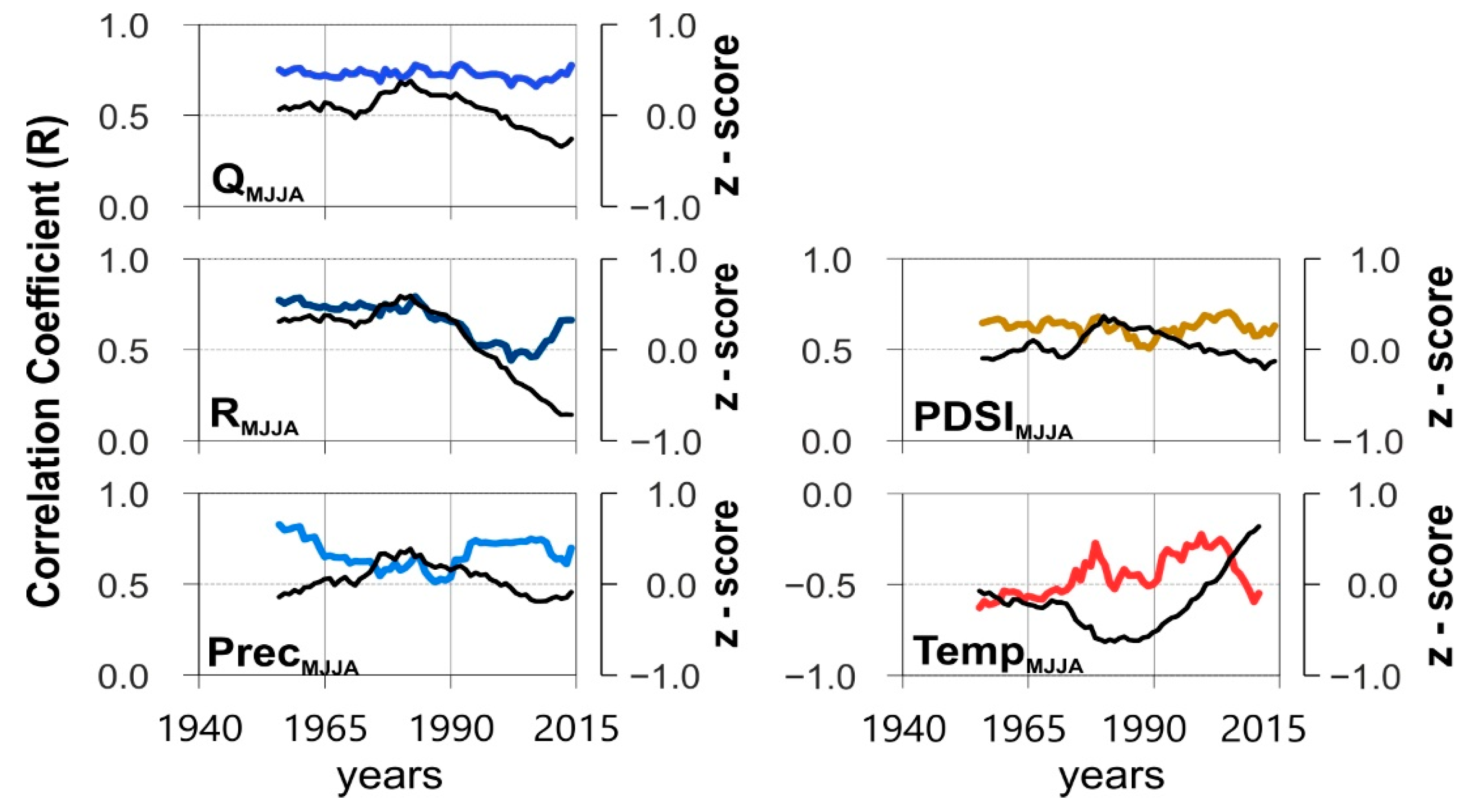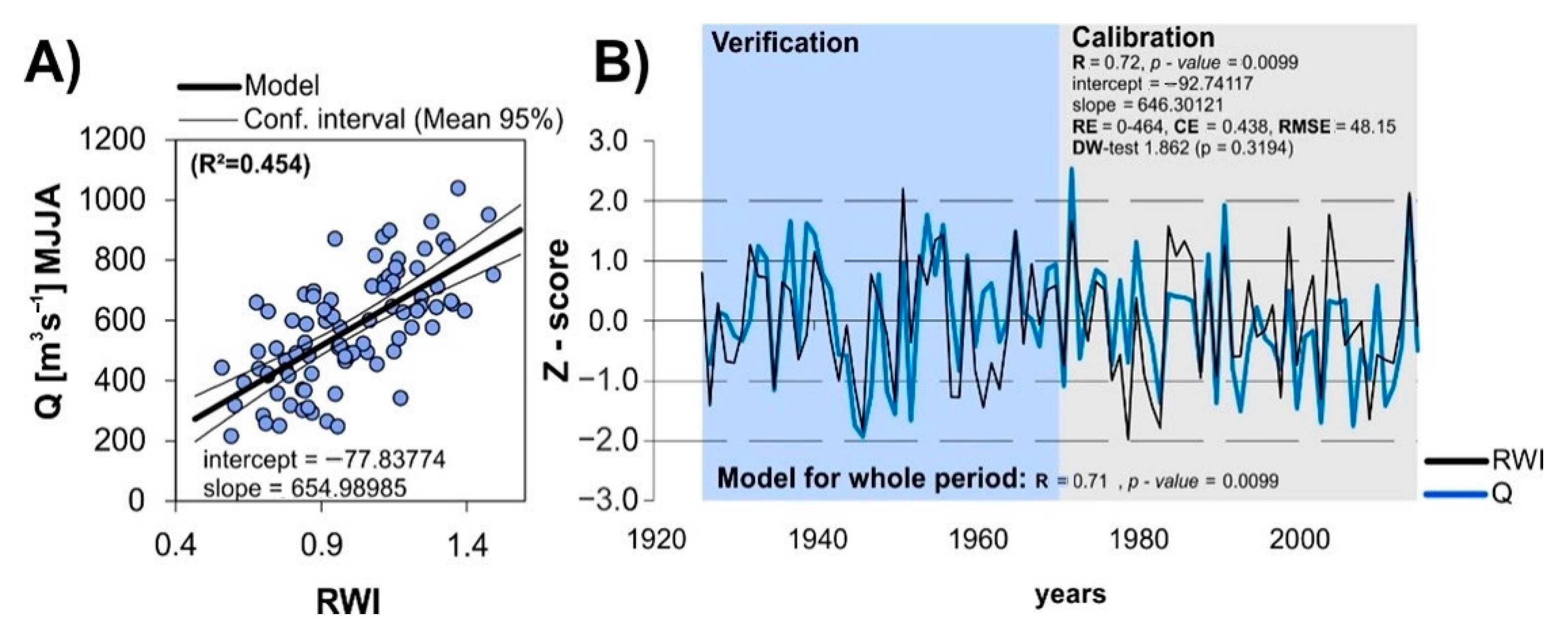Dendrohydrological Reconstructions Based on Tree-Ring Width (TRW) Chronologies of Narrow-Leaved Ash in the Sava River Basin (Croatia)
Abstract
1. Introduction
2. Materials and Methods
2.1. Research Area
2.2. Sample Collection and Data Processing
2.3. Climate Data
2.4. Correlation Analysis
3. Results
3.1. Chronology Statistics
3.2. Climate Growth Relationship
3.3. Temporal Stability of the Climate and Hydrological Signal
3.4. Potential for Streamflow Reconstruction
4. Discussion
Supplementary Materials
Author Contributions
Funding
Institutional Review Board Statement
Informed Consent Statement
Data Availability Statement
Acknowledgments
Conflicts of Interest
References
- Auer, I.; Böhm, R.; Jurkovic, A.; Lipa, W.; Orlik, A.; Potzmann, R.; Schöner, W.; Ungersböck, M.; Matulla, C.; Briffa, K.; et al. HISTALP—Historical instrumental climatological surface time series of the Greater Alpine Region. Int. J. Climatol. 2007, 27, 17–46. [Google Scholar] [CrossRef]
- Giorgi, F.; Lionello, P. Climate change projections for the Mediterranean region. Glob. Planet. Chang. 2008, 63, 90–104. [Google Scholar] [CrossRef]
- Edenhofer, O. (Ed.) Climate Change 2014: Mitigation of Climate Change; Working Group III Contribution to the Fifth Assessment Report of the Intergovernmental Panel on Climate Change; IPCC; Climate Change 2014; Cambridge Univ. Press: New York, NY, USA, 2014; ISBN 978-1-107-05821-7. [Google Scholar]
- Floodplain Management: Reducing Flood Risks and Restoring Healthy Ecosystems; European Environment Agency: Copenhagen, Denmark, 2016.
- Gaume, E.; Bain, V.; Bernardara, P.; Newinger, O.; Barbuc, M.; Bateman, A.; Blaškovičová, L.; Blöschl, G.; Borga, M.; Dumitrescu, A.; et al. A compilation of data on European flash floods. J. Hydrol. 2009, 367, 70–78. [Google Scholar] [CrossRef]
- Jaun, S.; Ahrens, B.; Walser, A.; Ewen, T.; Schär, C. A probabilistic view on the August 2005 floods in the upper Rhine catchment. Nat. Hazards Earth Syst. Sci. 2008, 8, 281–291. [Google Scholar] [CrossRef]
- Kundzewicz, Z.W.; Pińskwar, I.; Brakenridge, G.R. Large floods in Europe, 1985–2009. Hydrol. Sci. J. 2013, 58, 1–7. [Google Scholar] [CrossRef]
- Floods in the Balkans: Bosnia and Herzegovina, Croatia and Serbia Situation Report; WHO: Geneva, Switzerland, 2014.
- Communication on Flood Risk Management; Flood Prevention, Protection and Mitigation; European Commission: Brussels, Belgium, 2004.
- Alfieri, L.; Burek, P.; Feyen, L.; Forzieri, G. Global warming increases the frequency of river floods in Europe. Hydrol. Earth Syst. Sci. Discuss. 2015, 12, 1119–1152. [Google Scholar]
- Winsemius, H.C.; Aerts, J.C.J.H.; van Beek, L.P.H.; Bierkens, M.F.P.; Bouwman, A.; Jongman, B.; Kwadijk, J.C.J.; Ligtvoet, W.; Lucas, P.L.; van Vuuren, D.P.; et al. Global drivers of future river flood risk. Nat. Clim. Chang. 2016, 6, 381–385. [Google Scholar] [CrossRef]
- Fink, A.H.; Brücher, T.; Krüger, A.; Leckebusch, G.C.; Pinto, J.G.; Ulbrich, U. The 2003 European summer heatwaves and drought -synoptic diagnosis and impacts: European heatwave-impacts. Weather 2004, 59, 209–216. [Google Scholar] [CrossRef]
- Hanel, M.; Rakovec, O.; Markonis, Y.; Máca, P.; Samaniego, L.; Kyselý, J.; Kumar, R. Revisiting the recent European droughts from a long-term perspective. Sci. Rep. 2018, 8, 9499. [Google Scholar] [CrossRef] [PubMed]
- Cook, E.R.; Jacoby, G.C. Potomac River Streamflow Since 1730 as Reconstructed by Tree Rings. J. Clim. Appl. Meteorol. 1983, 22, 1659–1672. [Google Scholar] [CrossRef]
- Kames, S. Sensitivity of Vessels in Black Ash (Fraxinus nigra Marsh.) Tree Rings to Fire and Hydro-Climatic Variables. Master’s Thesis, University of Manitoba, Winnipeg, MB, Canada, 2009. [Google Scholar]
- Perez-Valdivia, C.; Sauchyn, D. Tree-ring reconstruction of groundwater levels in Alberta, Canada: Long term hydroclimatic variability. Dendrochronologia 2011, 29, 41–47. [Google Scholar] [CrossRef]
- Shah, S.K.; Bhattacharyya, A.; Chaudhary, V. Streamflow reconstruction of Eastern Himalaya River, Lachen ‘Chhu’, North Sikkim, based on tree-ring data of Larix griffithiana from Zemu Glacier basin. Dendrochronologia 2014, 32, 97–106. [Google Scholar] [CrossRef]
- Speer, J.H.; Shah, S.K.; Truettner, C.; Pacheco, A.; Bekker, M.F.; Dukpa, D.; Cook, E.R.; Tenzin, K. Flood history and river flow variability recorded in tree rings on the Dhur River, Bhutan. Dendrochronologia 2019, 56, 125605. [Google Scholar] [CrossRef]
- Tockner, K.; Stanford, J.A. Riverine flood plains: Present state and future trends. Environ. Conserv. 2002, 29, 308–330. [Google Scholar] [CrossRef]
- Robinson, M.; Cognard-Plancq, A.-L.; Cosandey, C.; David, J.; Durand, P.; Führer, H.-W.; Hall, R.; Hendriques, M.O.; Marc, V.; McCarthy, R.; et al. Studies of the impact of forests on peak flows and baseflows: A European perspective. For. Ecol. Manag. 2003, 186, 85–97. [Google Scholar] [CrossRef]
- Bradshaw, C.J.A.; Sodhi, N.S.; Peh, K.S.-H.; Brook, B.W. Global evidence that deforestation amplifies flood risk and severity in the developing world. Glob. Chang. Biol. 2007, 13, 2379–2395. [Google Scholar] [CrossRef]
- Hughes, F.M.R.; del Tánago, M.G.; Mountford, J.O. Restoring Floodplain Forests in Europe. In A Goal-Oriented Approach to Forest Landscape Restoration; Stanturf, J., Madsen, P., Lamb, D., Eds.; World Forests; Springer: Dordrecht, The Netherlands, 2012; Volume 16, pp. 393–422. ISBN 978-94-007-5337-2. [Google Scholar]
- Schneider, E. Floodplain Restoration of Large European Rivers, with Examples from the Rhine and the Danube. In Restoration of Lakes, Streams, Floodplains, and Bogs in Europe; Eiseltová, M., Ed.; Wetlands: Ecology, Conservation and Management; Springer: Dordrecht, The Netherlands, 2010; Volume 3, pp. 185–223. ISBN 978-90-481-9264-9. [Google Scholar]
- Horner, G.J.; Baker, P.J.; Nally, R.M.; Cunningham, S.C.; Thomson, J.R.; Hamilton, F. Mortality of developing floodplain forests subjected to a drying climate and water extraction. Glob. Chang. Biol. 2009, 15, 2176–2186. [Google Scholar] [CrossRef]
- Pittock, J.; Hansen, L.J.; Abell, R. Running dry: Freshwater biodiversity, protected areas and climate change. Biodiversity 2008, 9, 30–38. [Google Scholar] [CrossRef]
- Boshier, D. Ash Species in Europe: Biological Characteristics and Practical Guidelines for Sustainable Use; Oxford Forestry Institute: Oxford, UK, 2005; ISBN 978-0-85074-163-6. [Google Scholar]
- Marques, I.C.G. Fraxinus Angustifolia Vahl as a Valuable Species in Riparian Rehabilitation Projects. From Annual Growth to Habitat Preference of Narrow-Leaved Ash in Southern Portugal. Master’s Thesis, ISA-University of Lisbon, Lisboa, Portugal, 2016. [Google Scholar]
- Mikac, S.; Žmegač, A.; Trlin, D.; Paulić, V.; Oršanić, M.; Anić, I. Drought-induced shift in tree response to climate in floodplain forests of Southeastern Europe. Sci. Rep. 2018, 8, 16495. [Google Scholar] [CrossRef]
- Muñoz, N.G.; Linares, J.C.; Castro-Díez, P.; Sass-Klaassen, U. Contrasting secondary growth and water use efficiency patterns in native and exotic trees co-occurring in inner Spain riparian forests. For. Syst. 2015, 24, 017. [Google Scholar]
- Pernar, N.; Anić, I.; Jazbec, A.; Bakšić, D. The degree of soil water saturation in the narrow-leaved ash (Fraxinus angustifolia Vahl.) Floodplain forest. Ekologia 2007, 26, 258–272. [Google Scholar]
- Levanič, T. Atrics–A New System for Image Acquisition in Dendrochronology. Tree-Ring Res. 2007, 63, 117–122. [Google Scholar] [CrossRef]
- Baillie, M.G.L.; Pilcher, J.R. A simple crossdating program for tree-ring research. Tree-Ring Bull. 1973, 33, 7–14. [Google Scholar]
- Schweingruber, F.H. Tree Rings: Basics and Applications of Dendrochronology; Springer: Dordrecht, The Netherlands, 1988; pp. 51–68. ISBN 978-94-009-1273-1. [Google Scholar]
- Holmes, R.L. Computer-assisted quality control in tree-ring dating and measurement. Tree Ring Bull. 1983, 44, 69–78. [Google Scholar]
- Cook, E.R.; Krusic, P.J. Program ARSTAN, a Tree-Ring Standardization Program based on Detrending and Autoregressive Time Series Modeling with Interactive Graphics; Ree-Ring Laboratory Lamont Doherty Earth Observatory of Columbia University: New York, NY, USA, 2005. [Google Scholar]
- Cook, E.R.; Peters, K. Calculating unbiased tree-ring indices for the study of climatic and environmental change. Holocene 1997, 7, 361–370. [Google Scholar] [CrossRef]
- Mosteller, F.; Tukey, J.W. Data Analysis and Regression: A Second Course in Statistics; Addison-Wesley: Boston, MA, USA, 1977; ISBN 978-0-201-04854-4. [Google Scholar]
- Fritts, H.C. Tree Rings and Climate; Academic Press: London, UK; New York, NY, USA, 1976; ISBN 978-0-12-268450-0. [Google Scholar]
- Wigley, T.M.L.; Briffa, K.R.; Jones, P.D. On the average value of correlated time series, with applications in dendroclimatology and hydrometeorology. J. Clim. Appl. Meteorol. 1984, 23, 201–213. [Google Scholar] [CrossRef]
- Harris, I.; Jones, P.D.; Osborn, T.J.; Lister, D.H. Updated high-resolution grids of monthly climatic observations-the CRU TS3.10 Dataset: Updated High-Resolution Grids of Monthly Climatic Observations. Int. J. Climatol. 2014, 34, 623–642. [Google Scholar] [CrossRef]
- Alley, W.M. The Palmer Drought Severity Index: Limitations and Assumptions. J. Clim. Appl. Meteorol. 1984, 23, 1100–1109. [Google Scholar] [CrossRef]
- Zang, C.; Biondi, F. Dendroclimatic calibration in R: The bootRes package for response and correlation function analysis. Dendrochronologia 2013, 31, 68–74. [Google Scholar] [CrossRef]
- Pušpure, I.; Gerra-Inohosa, L.; Matisons, R.; Laiviņš, M. Tree-ring width of European ash differing by crown condition and its relationship with climatic factors in Latvia. Balt. For. 2017, 23, 244–252. [Google Scholar]
- Okonski, B. Radial growth of pedunculate oak and European ash on active river terraces: Hydrologic and climatic controls. Infrastrukt. Ekol. Teren. Wiej./Infrastucture Ecol. Rural Areas 2017, III/1, 1075–1091. [Google Scholar]
- Salas, J.D.; Tarawneh, Z.; Biondi, F. A hydrological record extension model for reconstructing streamflows from tree-ring chronologies: Dendrohydrological record extension model. Hydrol. Process. 2015, 29, 544–556. [Google Scholar] [CrossRef]
- Meko, D.; Stockton, C.W.; Boggess, W.R. The tree-ring record of severe sustained drought. J. Am. Water Resour. Assoc. 1995, 31, 789–801. [Google Scholar] [CrossRef]
- Koprowski, M.; Okoński, B.; Gričar, J.; Puchałka, R. Streamflow as an ecological factor influencing radial growth of European ash (Fraxinus excelsior (L.)). Ecol. Indic. 2018, 85, 390–399. [Google Scholar] [CrossRef]
- Cleaveland, M.K.; Stahle, D.W. Tree ring analysis of surplus and deficit runoff in the White River, Arkansas. Water Resour. Res. 1989, 25, 1391–1401. [Google Scholar] [CrossRef]
- Prpić, B. Korijenov sistem poljskog jasena (Fraxinus angustifolia Vahl) u različitim tipovima posavskih nizinskih šuma. Glas. Za Šumske Pokuse 1974, 17, 253–336. [Google Scholar]
- Kuspilić, N.; Gilja, G. Potencijalan Učinak Morfoloških Promjena Rijeke Save na Zagrebački Vodonosnik; Strategija Razvoja Vodopskrbe i Odvodnje Grada Zagreba: Zagreb, Croatia, 17–18 May 2016; p. 11. [Google Scholar]
- Jones, P.D.; Briffa, K.R.; Pilcher, J.R. Riverflow reconstruction from tree rings in southern Britain. J. Climatol. 1984, 4, 461–472. [Google Scholar] [CrossRef]
- Karanitsch-Ackerl, S.; Mayer, K.; Gauster, T.; Laaha, G.; Holawe, F.; Wimmer, R.; Grabner, M. A 400-year reconstruction of spring–summer precipitation and summer low flow from regional tree-ring chronologies in North-Eastern Austria. J. Hydrol. 2019, 577, 123986. [Google Scholar] [CrossRef]
- Buntgen, U.; Tegel, W.; Nicolussi, K.; McCormick, M.; Frank, D.; Trouet, V.; Kaplan, J.O.; Herzig, F.; Heussner, K.-U.; Wanner, H.; et al. 2500 Years of European Climate Variability and Human Susceptibility. Science 2011, 331, 578–582. [Google Scholar] [CrossRef]
- Raffalli-Delerce, G.; Masson-Delmotte, V.; Dupouey, J.L.; Stievenard, M.; Breda, N.; Moisselin, J.M. Reconstruction of summer droughts using tree-ring cellulose isotopes: A calibration study with living oaks from Brittany (western France). Tellus B Chem. Phys. Meteorol. 2004, 56, 160–174. [Google Scholar] [CrossRef]
- Čufar, K.; De Luis, M.; Eckstein, D.; Kajfež-Bogataj, L. Reconstructing dry and wet summers in SE Slovenia from oak tree-ring series. Int. J. Biometeorol. 2008, 52, 607–615. [Google Scholar] [CrossRef]
- Woodhouse, C.A. A tree-ring reconstruction of streamflow for the colorado front range. JAWRA J. Am. Water Resour. Assoc. 2001, 37, 561–569. [Google Scholar] [CrossRef]
- Woodhouse, C.A.; Lukas, J.J. Multi-Century Tree-Ring Reconstructions of Colorado Streamflow for Water Resource Planning. Clim. Chang. 2006, 78, 293–315. [Google Scholar] [CrossRef]
- Anderson, S.; Ogle, R.; Tootle, G.; Oubeidillah, A. Oubeidillah Tree-Ring Reconstructions of Streamflow for the Tennessee Valley. Hydrology 2019, 6, 34. [Google Scholar] [CrossRef]
- Allen, E.B.; Rittenour, T.M.; DeRose, R.J.; Bekker, M.F.; Kjelgren, R.; Buckley, B.M. A tree-ring based reconstruction of Logan River streamflow, northern Utah: Logan river reconstruction. Water Resour. Res. 2013, 49, 8579–8588. [Google Scholar] [CrossRef]
- Barnett, F.A.; Gray, S.T.; Tootle, G.A. Upper Green River Basin (United States) Streamflow Reconstructions. J. Hydrol. Eng. 2010, 15, 567–579. [Google Scholar] [CrossRef]
- Watson, T.A.; Anthony Barnett, F.; Gray, S.T.; Tootle, G.A. Reconstructed Streamflows for the Headwaters of the Wind River, Wyoming, United States. JAWRA J. Am. Water Resour. Assoc. 2009, 45, 224–236. [Google Scholar] [CrossRef]
- Oršanić, M.; Mikac, S.; Ugarković, D.; Drvodelić, D.; Diminić, D.; Kranjec Orlović, J.; Milotić, M.; Hrašovec, B.; Franjević, M.; Vucelja, M.; et al. Ekologija, Obnova i Zaštita Poplavnih Šuma Posavine; Sveučilište u Zagrebu, Šumarski Fakultet: Zagreb, Croatia, 2020. [Google Scholar]





Publisher’s Note: MDPI stays neutral with regard to jurisdictional claims in published maps and institutional affiliations. |
© 2021 by the authors. Licensee MDPI, Basel, Switzerland. This article is an open access article distributed under the terms and conditions of the Creative Commons Attribution (CC BY) license (http://creativecommons.org/licenses/by/4.0/).
Share and Cite
Trlin, D.; Mikac, S.; Žmegač, A.; Orešković, M. Dendrohydrological Reconstructions Based on Tree-Ring Width (TRW) Chronologies of Narrow-Leaved Ash in the Sava River Basin (Croatia). Sustainability 2021, 13, 2408. https://doi.org/10.3390/su13042408
Trlin D, Mikac S, Žmegač A, Orešković M. Dendrohydrological Reconstructions Based on Tree-Ring Width (TRW) Chronologies of Narrow-Leaved Ash in the Sava River Basin (Croatia). Sustainability. 2021; 13(4):2408. https://doi.org/10.3390/su13042408
Chicago/Turabian StyleTrlin, Domagoj, Stjepan Mikac, Anja Žmegač, and Marko Orešković. 2021. "Dendrohydrological Reconstructions Based on Tree-Ring Width (TRW) Chronologies of Narrow-Leaved Ash in the Sava River Basin (Croatia)" Sustainability 13, no. 4: 2408. https://doi.org/10.3390/su13042408
APA StyleTrlin, D., Mikac, S., Žmegač, A., & Orešković, M. (2021). Dendrohydrological Reconstructions Based on Tree-Ring Width (TRW) Chronologies of Narrow-Leaved Ash in the Sava River Basin (Croatia). Sustainability, 13(4), 2408. https://doi.org/10.3390/su13042408





